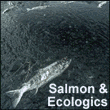forum
library
tutorial
contact

Chinook Fishery Debate Begins
by Mark Yuasa, Staff WriterSeattle Times, January 8, 2006
|
the film forum library tutorial contact |

|
Chinook Fishery Debate Beginsby Mark Yuasa, Staff WriterSeattle Times, January 8, 2006 |
The great debate over how Columbia River spring chinook are split between sport and non-tribal commercial fishers began Friday in Salem, Ore.
The Oregon Fish and Wildlife Commission's seven members met primarily to discuss spring chinook allocation for this season, and about 50 supporters from the sport fishing industry provided testimony.
The sticking point for sport fishing supporters is their claim to have paid a huge price the past five years because the non-tribal gill-net fleet has overharvested its percentage of the forecasted return.
The early part of the commercial gill-net catch, which usually starts at the end of February, is based on preseason forecasts. A commercial sturgeon fishery that starts Tuesday and runs to Feb. 22 is also allowed to sell any incidentally caught spring chinook.
The sport fishers claim that the only way they actually validate the forecasted "computer-modeled" return is by seeing the in-season updated forecast in late April, when about half the run has been through Bonneville Dam's fish counter.
The sport fishers also say the economic impact is huge, not only to guides and tackle shops, but also restaurants, stores and motels. In 2004, the sport fishery generated $20.6 million in additional revenue, while the commercial fishery made $1.6 million.
The delicious oily spring chinook in the Columbia River are highly sought after by both groups, and their value is right up there with Copper River chinook in Alaska.
Sport and commercial fishers are allowed to catch only hatchery spring chinook with a missing adipose fin. Last year's run was 41 percent below the forecast of 254,100 springers; the actual return was 105,000.
"This year's run forecast is 88,400 for wild upriver spring chinook," said Joe Hymer, a state Fish and Wildlife biologist. "That means [under the federal Endangered Species Act] non-tribal fishers can harvest up to 2 percent of the wild upriver fish below Bonneville," Hymer said. "If the run comes in lower [than 82,000], then the percentage of what people can catch drops."
Sport fishing advocates would like to stick to the 60-40 percentage or higher split of the 2 percent share. Commercial interests want it changed to 50-50.
After two consecutive years of miscalculated forecasts, fisheries managers are planning to be cautious in not allowing liberal catches during the early part of the fishery.
"By working cooperatively, Washington and Oregon have been able to provide important recreational and commercial fishing opportunities, while also providing protection for wild fish," said Bill Tweit, a state Fish and Wildlife Columbia River policy leader.
The nine-member Washington Fish and Wildlife Commission will meet at 9 a.m. Friday and Saturday in the Natural Resources Building in Olympia. Public comment periods are scheduled both days. Fisheries officials will make a final decision on Jan. 26.
learn more on topics covered in the film
see the video
read the script
learn the songs
discussion forum
